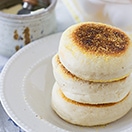Sourdough English Muffins
- Cook Time: 16 minutes
- Total Time: 16 minutes
- Yield: about 20-22 english muffins 1x
Ingredients
Scale
- 8 ounces (1 cup) warm water (110º-115ºF)
- 2 tablespoons granulated sugar
- 3 1/2 teaspoons active dry yeast
- 8 1/2 ounces (1 cup) milk
- 17 ounces (4 cups, spoon and level) all-purpose flour, divided
- 9 1/8 ounces (1 cup) sourdough starter
- 12 3/4 ounces (3 cups, spoon and level) bread flour, divided
- 2 ounces (1/4 cup) butter, softened and cubed
- 1 tablespoon salt
- cornmeal, for rolling and dusting
Instructions
- Sprinkle sugar over warm water in the bowl of a stand mixer. Stir in with a wooden spoon to dissolve. Sprinkle the yeast on top, stir in, and let sit for about 10 minutes, until foamy.
- Meanwhile, scald the milk in the microwave (or on the stove) by heating until the temperature measures 180ºF on a reliable digital thermometer . Cool to 110º-115ºF before using.
- Add 4 1/4 ounces (1 cup) all-purpose flour and starter to the yeast mixture and stir in until relatively smooth. Let sit for another 10 minutes, or until very bubbly. Add 4 1/4 ounces (1 cup) bread flour, butter, cooled milk, and salt, and beat in using the mixer's paddle attachment on medium-low for about 2 minutes. Add the remaining 12 3/4 ounces (3 cups) all-purpose flour and 8 1/2 ounces (2 cups) bread flour and beat in on low speed until a dough begins to form.
- Switch to the dough hook and knead with hook on low speed for about 5 minutes, until the dough is soft and elastic and no longer sticks to the sides of the bowl. If the dough is too sticky, add a bit more bread flour sparingly as needed.
- Shape dough into a round with a smooth top and transfer to a greased bowl about twice its size, turning once to coat dough with cooking spray. Cover with greased plastic wrap and let rise until doubled. (For overnight rising, see notes below.)
- Punch risen dough down gently and let rest for 10 minutes. Meanwhile, dust a surface with cornmeal for rolling out the dough and lay out a few large sheets of parchment paper. Fill a shallow bowl or plate with extra cornmeal. Divide dough in half. Keep one half covered while rolling out other half to 1/2" thick and use a round cookie cutter, about 3"-3 1/2" in diameter, to cut out circles of dough. Dip top side of cut muffins in bowl/plate of cornmeal to coat, and then transfer to a sheet of parchment (well spread out) for second rising, covering with greased plastic wrap. Ball up remaining scraps from first half of dough and cover while repeating process with second half. Once done, kneads scraps from both halves together briefly and shape back into a smooth ball. Let rest for 10 minutes before rolling out and cutting remaining muffins. Let muffins rise, covered, until approximately doubled in size and very puffy.
- Heat your largest skillet/fry pan on medium-low heat for about 2 minutes. Carefully slide a few muffins, one by one, onto a large flat spatula and transfer to pan. Leave space between the muffins as they cook because they will expand. Cover and cook muffins for about 8 minutes, and then carefully flip and cook another 8 minutes or so on the second side. The muffins should be golden-brown and have an internal temperature of 200º-205ºF when done.* Adjust heat and cooking time as needed to ensure that the muffins turn golden-brown but don't burn. Once cooked, transfer muffins to a wire rack to cool while cooking remaining muffins. Serve warm/toasted with melted butter, jam, jelly, etc. Store in an airtight container or zip-top bag at room temperature.
Notes
*If you don't have a kitchen thermometer to measure the internal temperature of the muffins when cooking them, I'd recommend that you split the first one open when you're done to make sure it's fully cooked.
Overnight Rise:
After making the dough, place in the refrigerator to rise overnight. The following day, take the dough out of the refrigerator and, if not yet doubled in size, allow to rise further at room temperature. Once dough has risen to doubled, continue with step 6.
Recipe Adapted From: King Arthur Flour and Simmer Seasonal Recipes
Find it online: https://www.brighteyedbaker.com/sourdough-english-muffins/
